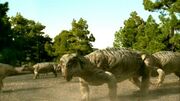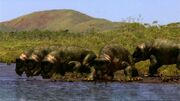Squatters are a group of herbivorous non-mammal synapsids part of the Dicynodont family, which also includes the bear-sized lizardpigs, which also evolved from the same ancestors that survived both the Triassic and the K-T mass extinction and made it to modern New Zealand. Squatters are a more primitive group that resembles their Triassic counterparts. Today, there are only two different squatter species and are native only to New Zealand.
Common Squatter[]

A herd of common squatters looking for new areas for newer food sources.
Common Squatters are a species of squatter native to both North Island and South Island. They resemble an extinct Triassic Lystrosaurus, in which is probably related to. They mainly feed on roots, tubers, leaves, fruits, and other plant foods. They are about the size of a pig, making them not very large compared to other modern Dicynodonts, but they are the most common species, living in just about every New Zealand habitats, due to their tolerance to both heat and cold, as well as humid and arid climates, and they live in relatively larger herds ranging from about 21 individuals to the largest known common squatter herd in history, which contained about 292 individuals. They are not endangered since they tolerate habitat loss, climate changes, and introduced species.
Greater Squatter[]

A herd of greater squatters drinking at a large river.
Greater Squatters are large hippopotamus-sized Placerias-like Dicynodonts native to South Island and parts of North Island. They normally feed on roots, tubers, leaves, and other plant matters. They are one of the main rivals to the common squatters. They are normally docile to humans and most native New Zealand herbivores, but can act aggressively towards their rivals, common squatters, due to the fact that they compete for food. They are not endangered since they tolerate habitat loss, climate changes, and introduced species.
